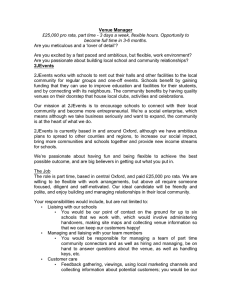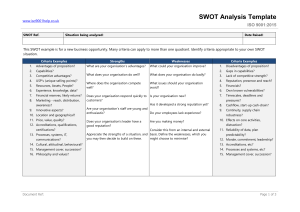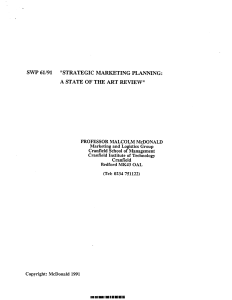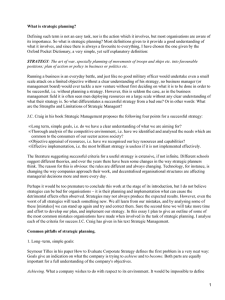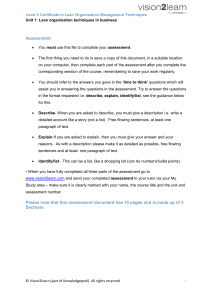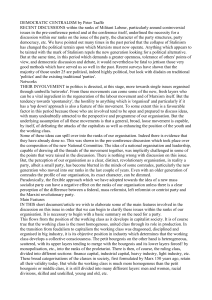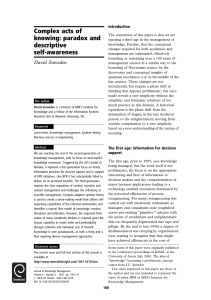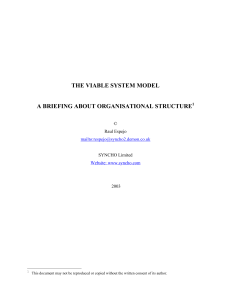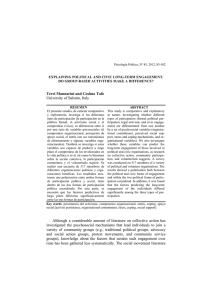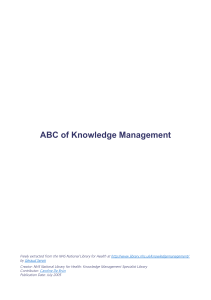FORMAL ORGANISATION Introduction The structure of a business organisation
Anuncio
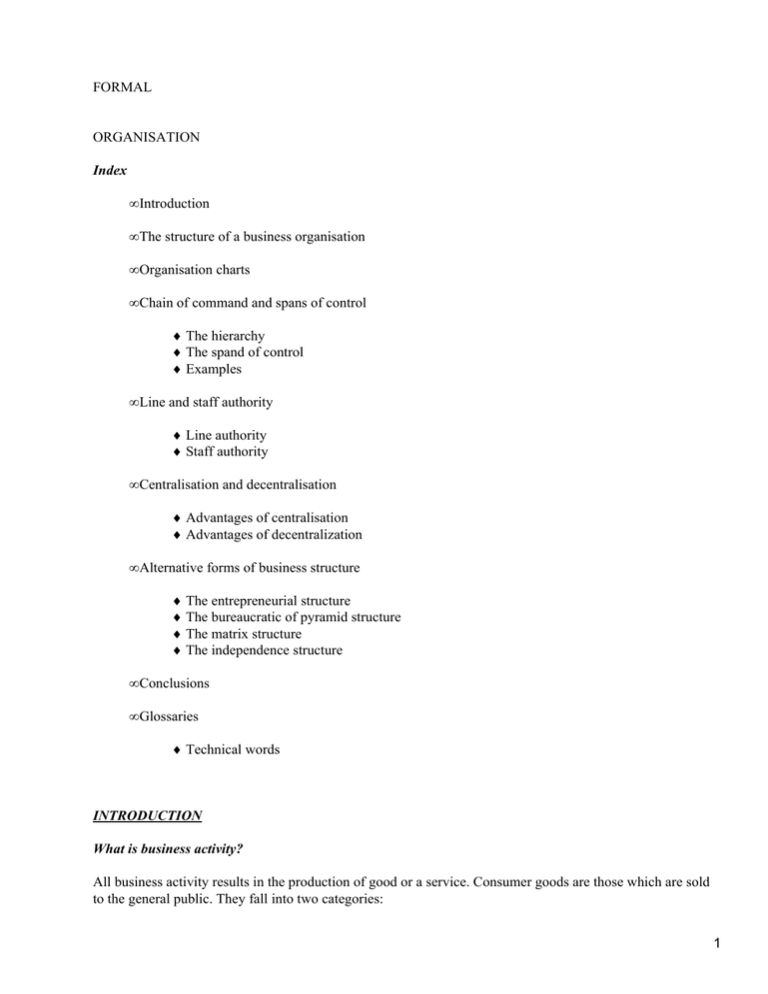
FORMAL ORGANISATION Index • Introduction • The structure of a business organisation • Organisation charts • Chain of command and spans of control ♦ The hierarchy ♦ The spand of control ♦ Examples • Line and staff authority ♦ Line authority ♦ Staff authority • Centralisation and decentralisation ♦ Advantages of centralisation ♦ Advantages of decentralization • Alternative forms of business structure ♦ The entrepreneurial structure ♦ The bureaucratic of pyramid structure ♦ The matrix structure ♦ The independence structure • Conclusions • Glossaries ♦ Technical words INTRODUCTION What is business activity? All business activity results in the production of good or a service. Consumer goods are those which are sold to the general public. They fall into two categories: 1 • Durable goods such as cookers, televisions, books, cars, and furniture can be used repeatedly for a long period of time. • Non−durable good such as food, confectionery, cigarettes and shoe are used very soon after they are purchased. Capital goods: are those goods purchased by business and used to produce other goods. Tools equipment and machinery are examples of capital goods. What is a business organisation? An organisation is a body that is set up to meet need. Business organisations satisfy needs by providing people with goods and services. All organisations will: • Try to achieve objectives. • Use resources. • Need to be directed. • Have to be accountable. • Have to meet legal requirements. • Have a formal structure. FORMAL ORGANISATION THE STRUCTURE OF A BUSINESS ORGANISATION There are certain types of business organisation. However, each business organisations will have a different internal structure. The way in which it is organised. The internal structure will take into account such things as: • The relationships between individuals. • Who is in charge. • Who is authority to make decisions. • Who carries out decisions. • How information is communicated. ORGANISATION CHARTS Many firms produce organisation charts. These illustrate the structure of the business. The firms draw such charts because: • To spot communication problems. An organisation chart indicates how employees are linked to other employees in the business. If information is not received, the business can find where the communication breakdown has occurred by tracing the communication chain a long the chart. • Organisation charts help individuals see their position in a firm. This can help them appreciated their responsibilities, who has authority over them and who they are accountable to. • Organisation charts allow firms to specify areas where specialists are needed. • Organisation charts show how different sections of the firm relate to each other. The firm will only achieve its objective if it understands the relationships between employees and other parts of business. EXAMPLE: 2 Chairperson Managing Director Assistant Assistant Manager Sales Manager Purchases CHAIN OF COMMAND AND SPAND OF CONTROL When deciding on its organisation structure, a business must take into account two important factors: • The hierarchy • The span of control The hierarchy in a business is the order or levels of management in a firm, from the lowest to the highest rank. Businesses generally try to keep chains as short as possible. The span of control this refers to the number of subordinates working under a superior or manager. In other words, if one production manager has ten subordinates his span of control is ten but the spand of control should be between three and six because: • There should be tight managerial control from the top of the business • There are physical and mental limitations to any single managers' ability to control people and activities. EXAMPLES: A long chain of command and narrow span of control. A narrow span of control has the advantage for a firm of tight control and close supervision. It also allows better co−ordination of subordinates' activities. In addition, it gives managers time to think and plan without having to burdened with too may day to day problems. A narrow span also ensures better communication with subordinates, who are sufficiently small in number to allow this to occur. One manager is helped by a few assistant managers, each responsible for supervisors. These supervisors are responsible for skilled workers, who are charge of a group of semi−skilled workers. A short chain of command and a wide span of control, this charts however, offers greater decision making authority for subordinates and may improve job satisfaction. Furthermore, there are likely to be lower costs involved in supervision. LINE AND STAFF AUTHORITY Line and staff are terms used to describe the type of relationship that managers may have with others in the hierarchy. 3 Line authority: Line authority is usual in a hierarchy. It shows the authority that a manager has over a subordinate. Communication will flow down from the superior to the subordinate in the chain of command. The advantage of this that a manager can assign work and control subordinates, who have a clear understanding of who is giving them subordinates, who have a clear understanding of who is giving them instructions. The manager can also delegate authority to other if they feel this will make decision making more effective Staff authority: staff authority might be when a manager a department in a business has a function within another department. Problems may meet in a business if people do not understand where authority and responsibility rest. This means that managers must know whether their authority is line or staff. Unfortunately this can lead to friction. CENTRALISATION AND DESENTRALISATION Centralisation and decentralisation refer to the extent to which authority is delegated in a business. If there was complete centralisation, then subordinates would have no authority at all. Complete decentralisation would mean subordinates would have all the authority to take decisions. Advantages of centralisation: • Senior management have more control of the business • Procedures, such as ordering and purchasing, can be standardised throughout the organisation, leading to economies of scale. • Senior managers can make decisions from the point of view of the business as a whole. Subordinates would tend to make decisions from the point of view of their department or section, this allows senior managers to maintain a balance between department or sections • Senior manager should be more experienced and skilful in making decisions • In times of crisis, the firm may need strong leadership by a central group of senior managers. Advantages of descentralisation: • It reduces the stress and burdens of senior management • It provides subordinates with greater job satisfaction by giving them more say in decision−making, which affects their work • Subordinates may have a better knowledge of local conditions affecting their area of work • Delegation should allow greater flexibility and a quicker response to changes. If problems do not have to be refereed to senior managers, decision−making will be quicker. • By allowing delegated authority, management at middle and junior levels are groomed to take over higher positions. They are given the experience of decision making when carrying out delegated tasks. ALTERNATIVE FORMS OF BUSINESS STRUCTURE The entrepreneurial structure In this type of business structure, all decisions are made centrally. There are few collective decisions and a great reliance on key workers. It is often found in business where decisions have to be made quickly. The bureaucratic or pyramid structure This is the traditional structure for most medium sized and large business and perhaps the best kwon. Decision making is shared throughout the business. Employees are each given a role and procedures are laid down which determine their behaviour at work. Specialisation of tasks is possible. 4 Information Decision Director Departmental managers Middle managers Employees The matrix structure: This structure getting people with particular specialist skills together into project teams. Individuals within the team have their own responsibility. Managers often argue that this is the best way of organisation people, because it is based on the competence and skills of employees and give possibility for people lower down the organisation to use their talents effectively. The independence structure: This emphasises the individual and is almost a non−organisation. This structure is a method of providing a support system. It is attractive to independent people who are confident of their ability to be successful. This form of organisation tends to be unsuitable for most types of business because of the lock of control and co−ordination. CONCLUSIONS The objective the one business is the production of a good or a service and for to get these objectives is necessary that the firm have a good organisation structure, for example the formal organisation. However, the organisation charts are very important too because illustrate the structure of the business, we can choose between different organisations charts and we can adapt it to our type firm, because a large firm is not equally that a medium size firm and this use different organisation charts, of course. So a one firm can be successful we must add the relationship between superior and subordinate and who has authority to make decisions. We can not forget that there are alternative forms of business structure for to choose the best that like us. GLOSSARY • Authority: The right to command a situation, a task or an activity. • Business structure: The way in which a business is organised. • Chain of command: The way authority and power are passed down in a business. • Delegation: Authority passed down from superior to subordinate. • Hierarchy: The order or levels of management of a business, from the lowest to the highest. • Organisation charts: A diagram which illustrate the structure of an organisation. • Responsibility: The duty to complete a task. • Span of control: The number of subordinates working under a superior. 5 REFERENCES • Business studies, 1993, editorial CPL. By: Dave Hall − Rob Jones − Carlos Raffo − Edited by Ian Chambers. • Relaciones en el entorno de trabajo, España 2004, editorial Mc Graw Hill By: Eva Escalante − Laura Griego. Supervisors Sales Supervisors Sales Supervisors Purchases Workers Workers Workers Workers Decisión Maker Workers Workers Individual Decisión Makers 6

